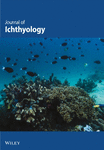Some aspects of osmotic and ionic regulation in Adriatic sturgeon Acipenser naccarii. I: Ontogenesis of salinity tolerance
E. Cataldi
Lab di Ecologia Sperimentale e Acquacoltura, Dip.di Biologia, Univ. di Roma Tor Vergata
Search for more papers by this authorP. Di Marco
Lab di Ecologia Sperimentale e Acquacoltura, Dip.di Biologia, Univ. di Roma Tor Vergata
Search for more papers by this authorC. Boglione
Lab di Ecologia Sperimentale e Acquacoltura, Dip.di Biologia, Univ. di Roma Tor Vergata
Search for more papers by this authorL. Dini
Department of Biology, University of Lecce, Lecce, Italy
Search for more papers by this authorS. Cataudella
Lab di Ecologia Sperimentale e Acquacoltura, Dip.di Biologia, Univ. di Roma Tor Vergata
Search for more papers by this authorE. Cataldi
Lab di Ecologia Sperimentale e Acquacoltura, Dip.di Biologia, Univ. di Roma Tor Vergata
Search for more papers by this authorP. Di Marco
Lab di Ecologia Sperimentale e Acquacoltura, Dip.di Biologia, Univ. di Roma Tor Vergata
Search for more papers by this authorC. Boglione
Lab di Ecologia Sperimentale e Acquacoltura, Dip.di Biologia, Univ. di Roma Tor Vergata
Search for more papers by this authorL. Dini
Department of Biology, University of Lecce, Lecce, Italy
Search for more papers by this authorS. Cataudella
Lab di Ecologia Sperimentale e Acquacoltura, Dip.di Biologia, Univ. di Roma Tor Vergata
Search for more papers by this authorSummary
The salinity tolerance of various early life stages (prelarvae, larvae and fry) of the Adriatic sturgeon (Acipenser naccarii) was investigated using acute exposures in a 96h-LC50 test. The results were compared with a series of parallel observations on the morphological development of the osmoregulatory organs. The highest salinities tolerated by prelarave and larvae were approximately iso-osmotic with sturgeon plasma. Once, however, the organs involved in homeostatic osmoregulatory mechanisms in the adult had developed (renal-branchial-gut system), the sturgeon was able to switch from hyper-osmoregulation to hypo-osmoregulation. Nevertheless, at the most advanced age tested (150 days old), water at a salinity of approximately 20%d̀ appeared to be the upper threshold for tolerance of acute exposure by this species.
References
- Ayson, F.G.; Kaneko, T.; Hasegawa, S.; Hirano, T., 1994: Development of mitochondrion-rich cells in yolk-sac menmbrane of embryos and larvae of tilapia, Oreochromis mossambicus, in freshwater and seawater. J.Exp. Zool, 270: 129–135.
- Cataldi, E.; Ciccotti, E.; Di Marco, P.; Di Santo, O.; Bronzi, P.; Cataudella, S., 1995: Acclimation trials of juvenile Italian sturgeon to different salinities: morpho-physiological descriptors. J. Fish Biol. 47: 609–618.
- Conte, F.P.; Wagner, H.H., 1965: Development of osmotic and ionic regulation in juvenile steelhead trout Salmo gairdneri Comp. Biochem. Physiol., 14: 603–620.
- Conte, F.P.; Wagner, H.H.; Fessler, J.; Gnose, C, 1966: Development of osmotic and ionic regulation in juvenile coho salmon Oncorhynchus kisutch Comp. Biochem. Physiol., 18: 1–15.
- Farmer, G.P.; Ritter, J. A.; Ashfield, D., 1978: Seawater adaptation and parr-smolt transformation of Juvenile Atlantic salmon, Salmo salar. J. Fish. Res. Bd. Can., 35: 93–100.
- Hoar, W.S., 1976: Smolt transformation: evolution, behavior, and physiology. J. Fish. Res. Board Can., 33: 1233–1252.
- Hwang, P.P., 1990: Salinity effects on development of chloride cells in the larvae of ayu (Plecoglossus altivelis). Marine Biology 107: 1–7.
- Hwang, P.P.; Wu, S.M., 1989: Morphological study on kidneys of tilapia larvae (Oreochromis mossambicus) hatched in freshwater and seawater. Bull. Inst. Zool. Academia Sinica 28: 73–80.
- Iwata, M; Hasegawa, S.; Hirano, T., 1982: Decreased seawater adaptability of chum salmon (Oncorhynchus keta) fry following prolonged rearing in freshwater. Can. J. Fish. Aquat. Sci., 39: 509–514.
- Kaneko, T.; Hasegavwa, S.; Takagi, Y.; Tagawa, M.; Hirano, T., 1995: Hypoosmoregulatory ability of eyed-stage embryos of chum salmon. Marin.Biol. 122: 165–170.
- Kojima, H.; Iwata, M.; Kurokawa, T., 1993: Development and temporal decrease in seawater adaptability during early growth in chum salmon Oncorhynchus keta 1993. Aquaculture, 118: 141–150.
- MacEnroe, M.; Cech, J.J., 1985: Osmoregulation in juvenile and adult white sturgeon Acipenser transmontanus Env. Biol. Fishes 14: 23–30.
- McKenzie, D.J.; Cataldi, E.; Di Marco, P.; Mandich, A.; Romano, P.; Ansferri, S.; Bronzi, P.; Cataudella, S., 1999: Some aspects of osmotic and ionic regulation in Adriatic sturgeon: II. Morpho-physiological adjustments to hyperosmotic environments. J. Appl. Ichthyol. This issue.
- Muir, B.S., 1969: Gill dimension as a function offish size. J. Fish. Res. Bd. Can., 26: 165–170.
- Nordlie, F.G.; Szelistowski, W.A.; Nordlie, W.C., 1982: Ontogenesis of osmotic regulatio in the striped mullet, Mugil cephalus L. J. Fish Biol., 20: 79–86.
- Paccagnella B., 1948: Osservazioni sulla biologia degli storioni del Bacino Padano. Archivi di Oceanogrqfia e Limnologia 5: 141–154.
- Parry G., 1960: The development of salinity tolerance in the salmon, Salmo salar and some related species. J. Exp. Biol., 37: 425–434.
- Rochard, E.; Castelnaud, G.; Lepage, M., 1990: Sturgeon (Pisces: Acipenseridae); threats and prospects. J. Fish Biol., 37 (Suppl A): 123–132.
- Rochard, E.; Williot, P.; Castelnaud, G.; Lepage, M., 1991: Elements de systematique et de biologie des populations sauvages ?esturgeons. In: Acipenser ( P. Williot ed.). Actes du premier colloque internationalsur ľestugeon, Bordeaux, 3–6 ottobre 1989. Bordeaux: CEMAGREF: 475–507.
- Rossi, R.; Grandi, G.; Trisolini, R.; Franzoi, P.; Carrieri, A.; Dezfuli, B.S., Vecchietti, E., 1992: Osservazioni sulla biologia e la pesca dello storione cobice Acipenser naccarii Bonaparte nella parte terminate del fiume Po. Atti Soc. Ital. Sci. Nat. Museo Civ. Storia Nat. di Milano 132: 121–142.
- Tortonese E., 1989: Acipenser naccarii Bonaparte 1837. In: The Freshwater Fishes of Europe. General Introduction to Fishes. Acipenseriformes. Vol. I, Part II ( J. Holcik, ed.), AULA-Verlag, Weisbaden .: 285–293.
- Watanabe, W.O.; Ellingson, L.J.; OHa, B.L.; Ernst, D.H.; Wicklund, R., 1990: Salinity tolerance and seawater survival vary ontogenetically in Florida Red Tilapia. Aquaculture, 87: 311–321.
- Weisbart, M., 1968: Osmotic and ionic regulation in embryo, alevins and fry of the five species of Pacific salmon. Can. J. Zool. 46: 385–397.




